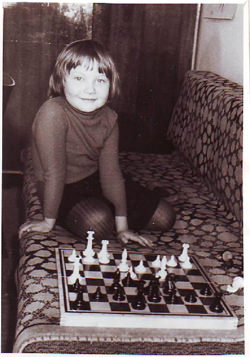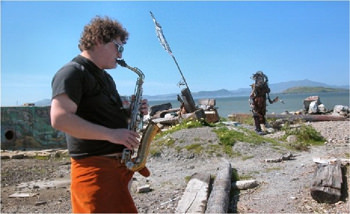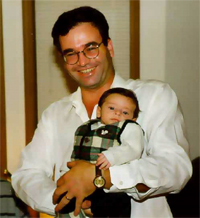
Adam in ~25 years

Lyudmila some time ago…

Dor deriving harmonic overtones
Meet the Theory Group in a time perspective!
Steve Adelman’s research concerns the dynamics of chemical reactions occurring in liquid solutions. He has developed a general theory of such processes based on the idea (implied by the Arrhenius rate law) that they occur in a fast solute/slow solvent regime, opposite to the traditional slow solute/ fast solvent Brownian motion regime. The theory gives the first correct picture of liquid phase reaction dynamics, as well as rate constant formulas which reflect that picture. To compare with experiment, methods for computing the rate constants from the solvent structure near the solute have been developed. “We apply these methods to the prototype (non-reactive) process of vibrational energy relaxation (VER) and compute the thermodynamic state dependencies of VER rates for a number of relaxing solutions. We have found molecular explanations for some observed general features of VER”, - says Prof. Adelman.
Research in Sabre Kais’s group focuses on developing finite size scaling and dimensional scaling methods to explore quantum criticality in complex chemical systems. Theoretical efforts are also devoted to developing new quantum algorithms for chemistry for both current quantum information processors and future quantum computers.
Adam Wasserman’s research focuses on Time-dependent Density Functional Theory (TDDFT). He enjoys trying to make TDDFT work in tough cases where it currently cannot be applied easily, like transport properties, strong-field electron dynamics, and negative-ion resonances. He likes to think about the nature of the chemical bond, and is studying a novel theory that provides new insight into this old question, central to Chemistry.
Lyudmila Slipchenko’s research concerns electronic excitations in the gas-phase and in the environment. She develops electronic structure codes and applies them to chemical systems where accurate analysis of electronic structure is a challenge. This could be a coupling of electronic excited states in a bichromophore or influence of a particular solvent on a chemical reaction. Lyudmila thinks that studying the nature of electronic excitations is a lot of fun. And, as Isaac Asimov says, “The most exciting phrase to hear in science, the one that heralds new discoveries, is not 'Eureka!' (I found it!) but 'That's funny ...'”.
Dor Ben-Amotz: Liquid Theory and Simulations
In addition to performing experiments which use light to measure the effects of liquids on molecular vibrations and reactions, we also use theoretical and computer simulation methods to better understand what is going on. For example, we have found that linear response theory and thermodynamic perturbation theory can be helpful in understanding the hydration thermodynamics of non-polar, polar and charged solutes. We also perform molecular dynamics simulations to investigate the structure, energy and fluctuations of water in the hydration-shell around molecules of various sizes and polarities. The latter studies aim to understanding the surprising effects of interfacial curvature on water structure and dynamics, and particularly its influence on the hydrophobic interactions between molecules of various sizes (ranging from small molecules such as ethanol to biological macromolecules).

Sabre with a future of quantum
chemistry

Steve’s first deep insight